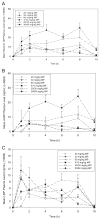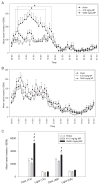A pharmacokinetic model of oral methylphenidate in the rat and effects on behavior
- PMID: 25641666
- PMCID: PMC4461871
- DOI: 10.1016/j.pbb.2015.01.005
A pharmacokinetic model of oral methylphenidate in the rat and effects on behavior
Abstract
Most animal studies using methylphenidate (MP) do not administer it the same way it is administered clinically (orally), but rather by injection, resulting in an altered pharmacokinetic profile (quicker and higher peak concentrations). We evaluated several oral-dosing regimens in rats, including dual-dose drinking, to mimic clinical drug delivery. Using an 8-hour-limited-access-drinking-paradigm, MP solutions were delivered at different doses (20, 30, or 60mg/kg/day; as well as dual-dosages of 4 and 10mg/kg/day, 20 and 30mg/kg/day, or 30 and 60mg/kg/day, in which the low dose was administered in the first hour of drinking followed by 7 h of drinking the high dose). Plasma was assayed for MP levels at many time points. Results showed that an 8-hour limited drinking of a dual-dosage 30/60mg/kg MP solution achieved a pharmacokinetic profile similar to clinically administered doses of MP at the high end of the spectrum (peaking at ~30ng/mL), while the 4/10mg/kg MP dual-dosage produced plasma levels in the range produced by typically prescribed clinical doses of MP (peaking at ~8ng/mL). Treatment with the higher dual-dosage (HD: 30/60mg/kg) resulted in hyperactivity, while the lower (LD: 4/10mg/kg) had no effect. Chronic effects of these dual-dosages were assessed throughout three months of treatment and one month of abstinence, beginning in adolescence. MP dose-dependently decreased body weight, which remained attenuated throughout abstinence. MP decreased food intake during early treatment, suggesting that MP may be an appetite suppressant and may also speed metabolism and/or suppress growth. Chronic HD MP resulted in hyperactivity limited during the dark cycle, decreased exploratory behavior, and increased anxiolytic behavior. Findings suggest that these dual-dosage-drinking-paradigms can be used to examine the effects of clinically relevant pharmacokinetic doses of MP and that chronic treatment with such dosages can result in long-lasting developmental and behavioral changes.
Keywords: Attention deficit hyperactivity disorder; Dopamine transporter; Methylphenidate; Psychostimulant; Ritalin.
Copyright © 2015 Elsevier Inc. All rights reserved.
Figures








References
-
- Aoyama T, Kotaki H, Iga T. Dose-dependent kinetics of methylphenidate enantiomers after oral administration of racemic methylphenidate to rats. J Pharmacobiodyn. 1990;13:647. - PubMed
-
- APA. Diagnostic and Statistical Manual of Mental Disorders: DSM-5. Washington, D.C: American Psychiatric Association; 2013.
-
- Balcombe JP, Barnard ND, Sandusky C. Laboratory routines cause animal stress. Contemp Top Lab Anim Sci. 2004;43:42–51. - PubMed
-
- Barone F, Wayner M, Lee H, Tsai W, Dehaven D, Woodson WJ. Effects of methylphenidate on food and water consumption at different body weights. Pharmacol Biochem Behav. 1979;10:591–5. - PubMed
-
- Barrickman LL, Perry PJ, Allen AJ, Kuperman S, Arndt SV, Herrmann KJ, et al. Bupropion versus methylphenidate in the treatment of attention-deficit hyperactivity disorder. J Am Acad Child Adolesc Psychiatry. 1995;34:649–57. - PubMed
Publication types
MeSH terms
Substances
Grants and funding
LinkOut - more resources
Full Text Sources
Other Literature Sources
Research Materials

